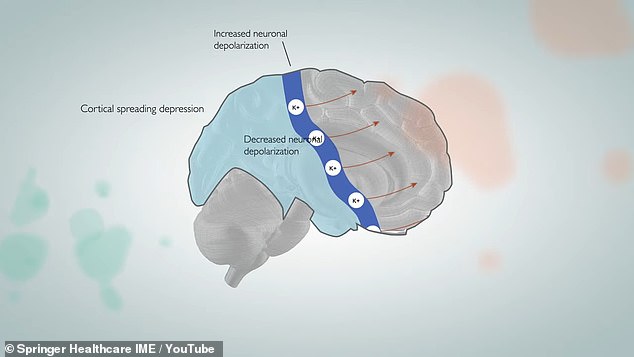Scientists say they may have discovered what causes common migraines — and how to treat them
Scientists have discovered a new way in which migraines are triggered, a breakthrough that could help them develop new drugs for this debilitating condition.
More than a million Americans suffer from migraines, leaving them feeling sick, incapacitating, and unable to get out of bed for hours.
One in four people also suffer from extreme light sensitivity, blurred vision and black spots, which makes it difficult for them to function.
Although migraine attacks are common, scientists still understand little about what causes them, and many people do not have effective medications.
Researchers have discovered that during a migraine with aura, specific proteins are produced that escape from the brain through microscopic openings and cause the severe pain.
About 12 percent of Americans have migraines, according to Dr. Gottschalk. Of those, about a quarter have migraines with aura, which involves strange visual distortions

Before some people feel a migraine, their vision is disrupted. This happens when a wave of signals shoots through the brain, as in the diagram above. These signals carry a fluid carrying proteins that cause migraines out of the brain and to pain receptors.
In order to feel pain, the migraine must activate pain receptors that are outside the migraine. Researchers have known this for a long time.
How migraines spread from the brain to the rest of the body remains “largely a mystery,” according to Dr. Jeffrey Iliff of the University of Washington School of Medicine and Dr. Andrew Russo of the University of Iowa, who were not involved in the study.
Dr. Iliff and Dr. Russo called the authors “pioneers” and said this could help us find new drugs for migraine patients, in a published answer to the new study.
For people with moderate headaches, over-the-counter pain relievers like Advil and Tylenol can often help. But for migraine sufferers, these are usually not enough.
There are FDA-approved medications for migraines, but they don’t work for many people, said the study authors from the University of Copenhagen and the University of Rochester Medical Center.
That’s because migraine is not just an annoying headache, but much more serious than that. Dr. Christopher Gottschalksaid the director of Yale Medicine’s Headache and Facial Pain Center, who was not involved in the study.
That’s why doctors prescribe medications such as triptans, which can treat migraines once they’ve started, or antidepressants, antiepileptics, or beta-blockers, all of which should be able to prevent migraines.
But there is a high degree of variability in these drugs. Even when they work, they have a number of unpleasant side effects such as nausea, insomnia, memory problems, weight gain and hair loss, Dr. Gottschalk said.
These side effects make these drugs “not a good solution” for many migraine sufferers, he said. “Often the cost is too high for people.”
But to create drugs that treat migraines more effectively, doctors need to understand what causes them. Despite “thousands of years” of research, the debate is still ongoing, the study authors said.
Scientists have long known that migraines do not directly affect the brain, because the brain itself cannot feel pain.
The brain is surrounded by multiple membranes that seal it off from the rest of the body and only allow things to pass through that are absolutely necessary. It is difficult for molecules to pass through these layers, whether they are coming or going.
Researchers had no idea how these troublesome migraines were able to bypass these barriers.
But they did know that with certain types of migraines, about an hour to five minutes before the pain starts, people experience strange visual phenomena, such as blurred vision, blinding lights and black spots.
It turns out that when an aura occurs, a flood of fluid and brain signals rush through the brain, propelling tiny molecules that cause migraines.
The study found that the molecules that cause migraines in mice escape through the brain’s fluid, pushing them out through a small opening where the nerve that controls the face exits the brain.
This was the first time anyone had identified this gap, Dr. Iliff and Dr. Russo wrote.
They think that these tiny particles, which are actually small proteins, can be targeted with new drugs and stop migraines.
“While this work provides some of the strongest data to date on the role of the glymphatic system in migraine, much remains to be discovered,” Dr. Illif and Russo wrote.
Some of the molecules identified in this new study were already being investigated by pharmaceutical companies, the researchers said.
In 2018, the FDA brought the first of these drugs to market, called calcitonin gene-related peptide inhibitors, named after the specific protein they are designed to target.
At the time, the American Migraine Foundation called this type of medication “the biggest news in migraine treatment and prevention in decades.” Still, it doesn’t cure everyone’s migraines.
The other molecules the researchers found could therefore be crucial, said study author Dr. Martin Kaag Rasmussen, in “discovering novel pharmacological targets that could be of benefit to the large proportion of patients who do not respond to available therapies.”
